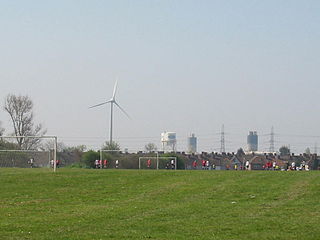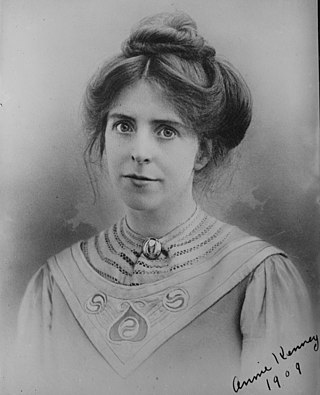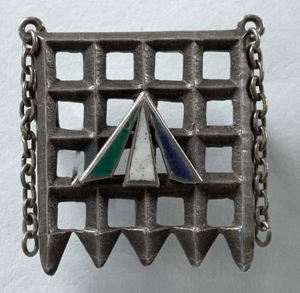
The London Borough of Barking and Dagenham is a London borough in East London. It lies around 9 miles (14.4 km) east of Central London. It is an Outer London borough and the south is within the London Riverside section of the Thames Gateway; an area designated as a national priority for urban regeneration. At the 2011 census it had a population of 187,000, the majority of which are within the Becontree estate. The borough's three main towns are Barking, Chadwell Heath and Dagenham. The local authority is the Barking and Dagenham London Borough Council. Barking and Dagenham was one of six London boroughs to host the 2012 Summer Olympics.

Dagenham is a town in East London, England, within the London Borough of Barking and Dagenham. Dagenham is centred 11.5 miles (18.5 km) east of Charing Cross.

Barking is a riverside town in East London, England, within the London Borough of Barking and Dagenham. It is 9.3 miles (15 km) east of Charing Cross, bordered by Ilford to the North, Dagenham to the East and East Ham, London to the West. The total population of Barking was 59,068 at the 2011 census. In addition to an extensive and fairly low-density residential area, the town centre forms a large retail and commercial district, currently a focus for regeneration. The former industrial lands to the south are being redeveloped as Barking Riverside.

Archant Limited is a newspaper and magazine publishing company with headquarters in Norwich, England. The group publishes four daily newspapers, around 50 weekly newspapers, and 80 consumer and contract magazines. The company is a subsidiary of Newsquest, which is owned by American newspaper publishing company Gannett.

University of East London (UEL) is a public university located in the London Borough of Newham, London, England, based at three campuses in Stratford and Docklands, following the opening of University Square Stratford in September 2013. The University of East London began as the West Ham Technical Institute and it was officially opened in October 1898 after approval was given for the construction of the site by the West Ham Technical Instruction Act Committee in 1892 following the Technical Instruction Act of 1889. It gained university status in 1992. It was formerly known as College of East London.

Barking & Dagenham College is a general further education college in East London, England. It is located at a single complex in the eastern part of the London Borough of Barking and Dagenham next to Central Park and less than a mile from the town centre of Romford.

East London is the northeastern part of London, England, east of the ancient City of London and north of the River Thames as it begins to widen. East London developed as London's docklands and the primary industrial centre. The expansion of railways in the 19th century encouraged the eastward expansion of the East End of London and a proliferation of new suburbs. The industrial lands of East London are today an area of regeneration, which are well advanced in places such as Canary Wharf and ongoing elsewhere.

Ann "Annie" Kenney was an English working-class suffragette and socialist feminist who became a leading figure in the Women's Social and Political Union. She co-founded its first branch in London with Minnie Baldock. Kenney attracted the attention of the press and public in 1905 when she and Christabel Pankhurst were imprisoned for several days for assault and obstruction related to the questioning of Sir Edward Grey at a Liberal rally in Manchester on the issue of votes for women. The incident is credited with inaugurating a new phase in the struggle for women's suffrage in the UK with the adoption of militant tactics. Annie had friendships with Emmeline Pethick-Lawrence, Baroness Pethick-Lawrence, Mary Blathwayt, Clara Codd, Adela Pankhurst, and Christabel Pankhurst.

Barking Riverside is a mixed-use development in the area of Barking, east London, England, within the London Borough of Barking and Dagenham. It is being built on land formerly occupied by Barking Power Station, adjacent to the River Thames, and is 10.5 miles (16.9km) east of Charing Cross. The 440 acre brownfield site has planning permission for 10,800 homes.

Valence House Museum is the only surviving of the five manor houses of Dagenham. The timber-framed museum building, partially surrounded by a moat, is situated in Valence Park off Becontree Avenue, in the London Borough of Barking and Dagenham, London, England. The building has been used as a manor house, a family home, a town hall, the headquarters of the library service and now houses a museum.

Glasgow Women's Library is a public library, registered company and charity based in the Bridgeton area of Glasgow, Scotland. It is the only accredited museum dedicated to women's history and provides information relevant to women's culture and achievements. It tries to operate on feminist principles. The library was awarded Recognised Collection of National Significance to Scotland status in 2015, as the collection contains valuable resources pertaining to women and their lives. In 2018, it was shortlisted for Museum of the Year. The museum supplies and encourages training and education, as well as skill-sharing via volunteers and/or staff.

The University of East London Stratford Campus is based in and around University House, a Grade II* listed building, located in Stratford, London in the London Borough of Newham. The nearest station is Maryland.

The Jack the Ripper Museum is a museum and tourist attraction that opened in August 2015 in Cable Street, London. It recreates the East end of London setting in which the unsolved Jack the Ripper murders took place in 1888, and exhibits some original artefacts from the period as well as waxwork recreations of crime scenes and sets. The museum was founded by Mark Palmer-Edgecumbe, a former head of diversity for Google.

Florence Eliza Haig (1856–1952) was a Scottish artist and suffragette who was decorated for imprisonments and hunger strikes.

Maud Joachim was a member of the Women's Social and Political Union, one of the groups of suffragettes that fought for women to get the right to vote in the United Kingdom. She was jailed several times for her protests. Joachim was one of the first suffragettes to go on hunger strike when imprisoned, a protest at not being recognised as political prisoners.

Jane Sbarborough (Sbarabara) (1842 — 1925) was born in Canada East but is known as a British suffragette. Along with Annie Kenney, and Adelaide Knight she was one of the Canning Town Three, according to the press. She was one of the early members of the first branch in London's East End of the Women's Social and Political Union.

Eleanor Grace Watney Roe (1885–1979) was Head of Suffragette operations for the Women's Social and Political Union. She was released from prison after the outbreak of World War I due to an amnesty for suffragettes negotiated with the government by the WSPU.

The Holloway brooch was presented by the Women's Social and Political Union (WPSU) to women who had been imprisoned at Holloway Prison for militant suffragette activity. It is also referred to as the "Portcullis badge", the "Holloway Prison brooch" and the "Victoria Cross of the Union".

The Hunger Strike Medal was a silver medal awarded between August 1909 and 1914 to suffragette prisoners by the leadership of the Women's Social and Political Union (WSPU). During their imprisonment, they went on hunger strike while serving their sentences in the prisons of the United Kingdom for acts of militancy in their campaign for women's suffrage. Many women were force-fed and their individual medals were created to reflect this.

Theodora Ellen Bonwick was a British headteacher, trade unionist, educationist and suffragette.
























